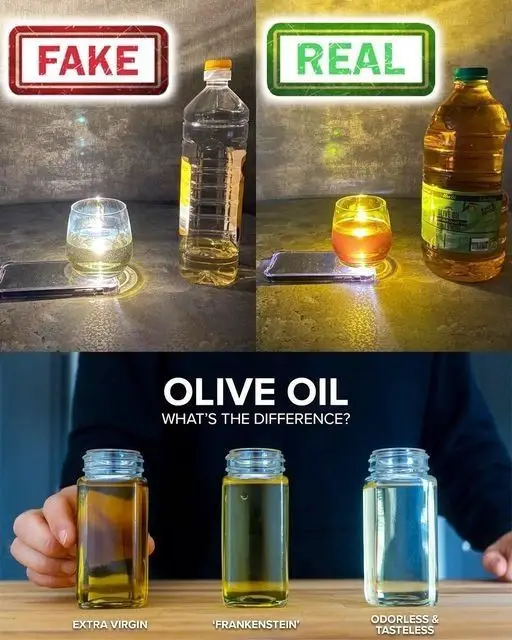Olive oil is often called “liquid gold,” but did you know a surprising amount of what’s sold as high-quality olive oil might be fake? From backyard brands to supermarket aisles, deception lurks in many bottles. Let’s uncover how to distinguish genuine extra virgin olive oil (EVOO) from imposters—and protect your wallet, taste buds, and health.
Why Fake Olive Oil Is More Common Than You Think
Global olive oil fraud is a serious issue. A recent investigation across Europe found police seized over 260,000 liters of counterfeit oil labeled as “extra virgin” epicurious.com+1nypost.com+1en.wikipedia.org+1en.wikipedia.org+1. In fact, in 2023 alone, Operation OPSON involved authorities from Spain and Italy busting a network that sold low-grade oils as premium EVOO. Some batches were even deemed unfit for consumption en.wikipedia.org+1nypost.com+1.
Historically, fraud rings have mixed olive oil with seed oils like sunflower or rapeseed, coloring it with chlorophyll or beta-carotene. In 2008, Italian police shut down oil plants adding chlorophyll-dyed sunflower and soybean oils to pass them off as EVOO en.wikipedia.org+5en.wikipedia.org+5en.wikipedia.org+5. Clearly, vigilance is vital.
Five Warning Signs You’re Buying Fake EVOO
- Check the Label
- Only bottles labeled “extra virgin” meet strict standards—anything else like “pure,” “light,” or “cold-pressed” lacks regulation bonappetit.comyoutube.com+9epicurious.com+9brightland.co+9.
- Always look for a harvest date, not just a “bottled on” or “best by” date. Freshness matters, especially if harvest is within the past 12 months pasolivo.com+9epicurious.com+9facebook.com+9.
- Look for Certification and Origin
- Trustworthy bottles include third-party seals: EU’s PDO, Italy’s DOP, California’s COOC, or NAOOA quality seals en.wikipedia.org+13epicurious.com+13brightland.co+13.
- The packaging should list both the country of origin and verifiable producer or estate name .
- Evaluate Taste, Smell, and Color
- Authentic EVOO features a fresh, green aroma, bold peppery bite, and slightly fruity taste thanks to polyphenols brightland.co+12brightland.co+12epicurious.com+12.
- Fake oils often taste dull, greasy, or waxy, resembling crayons southernliving.com+8brightland.co+8brightland.co+8.
- Vivid color and medium-thick texture signal purity; overly clear or watery oils can indicate dilution .
- Beware of the Fridge Test—It’s Not Foolproof
- Some claim refrigerating oil to see if it solidifies is a detection method. However, experts—including UC Davis Olive Center—warn it’s unreliable en.wikipedia.org+5pasolivo.com+5southernliving.com+5.
- The problem: EVOOs vary by variety, harvest date, filtration, and wax content, all of which affect freezing behavior pmc.ncbi.nlm.nih.gov+5pasolivo.com+5southernliving.com+5.
- As Dr. Payne from EVOO Times puts it, “the fridge test is completely false and misleading” pasolivo.com+1pasolivo.com+1.
- Price Isn’t Always a Guarantee
- High prices don’t always indicate authenticity—sometimes they mask clever marketing.
- Conversely, ultra-cheap options are likely adulterated or low-grade .
Beyond the Bottle: Advanced Testing Methods
Producers and regulators rely on scientific methods that are simply beyond home use:
- Chemical testing: Includes measuring acidity, peroxide values, ultraviolet extinction, fatty acid breakdown, sterol content, wax content, and chromatography en.wikipedia.org+1arxiv.org+1.
- DNA “invisible oil tags”: Novel traceability methods embed edible DNA barcodes to verify authenticity via PCR en.wikipedia.org.
- Technological innovations: Portable fluorescence-based devices and machine learning are being used in Spain to rapidly authenticate olive oils arxiv.org+1arxiv.org+1.
While home cooks won’t use these, knowing they exist adds confidence that EVOO fraud is being combated scientifically.
Smart Buying Habits for Consumers
Here’s how to protect yourself:
- Choose dark glass or tins to avoid exposure to light or air facebook.com+3southernliving.com+3redstoneoliveoil.com+3.
- Buy from local producers or reputable sellers—economically priced but transparently sourced, e.g., California-grown or local Mediterranean farms .
- Support certified producers: Look for NAOOA, COOC, DOP, PDO seals epicurious.com+1en.wikipedia.org+1.
- Prioritize form over flash: Fancy packaging doesn’t guarantee authenticity .
- Store correctly: Keep oil in dark, cool places, use within 18–24 months of harvest, and consume within months of opening southernliving.com.
Why It Matters: Health, Flavor, and Economics
Authentic EVOO offers:
- Health advantages: Rich in monounsaturated fats, polyphenols, and antioxidants.
- Flavor impact: Enhances salads, breads, grilled foods, and more with depth and complexity.
- Economic fairness: Properly compensated farmers benefit from transparent trade.
- Sustainability: Adulterated oils undercut trust in small producers and threaten fair agriculture practices.
As one expert warns: “Olive oil fraud typically involves mislabeling lower‑quality oils… or even dyeing cheap oils with chlorophyll and carotenes to mimic olive oil” redstoneoliveoil.comnypost.com. By being informed, you can avoid these pitfalls.
FAQs: Your Top Questions Answered
Q: So is the fridge test useless?
A: Experts agree it’s unreliable. Some real EVOOs won’t solidify due to their natural fat profiles and filtering techniques reddit.com+3pasolivo.com+3southernliving.com+3.
Q: Can I rely on fancy bottles?
A: Packaging isn’t a guarantee. Trust markings, certifications, and reputable sourcing—not aesthetics .
Q: Why do some oils cost more?
A: Quality production—early harvest, cold pressing, third-party testing—costs more. Beware inflated prices without credentials .
Final Takeaway: Choose Authentic EVOO with Confidence
Here’s your checklist:
- “Extra virgin” label—no vague terms.
- Harvest date within 24 months.
- Certifications like PDO/DOP/COOC/NAOOA.
- Producer’s name and origin clearly visible.
- Dark bottle or tin packaging.
- Fresh, peppery flavor and vibrant green hue.
- Trusted place of purchase, not just flashy shelf appeal.
When shopping for olive oil, don’t just buy a bottle—choose the real deal. In doing so, you’ll enjoy superior taste, better health benefits, and support honest farming. And next time you drizzle that “liquid gold,” you’ll know exactly what—and who—is inside.

